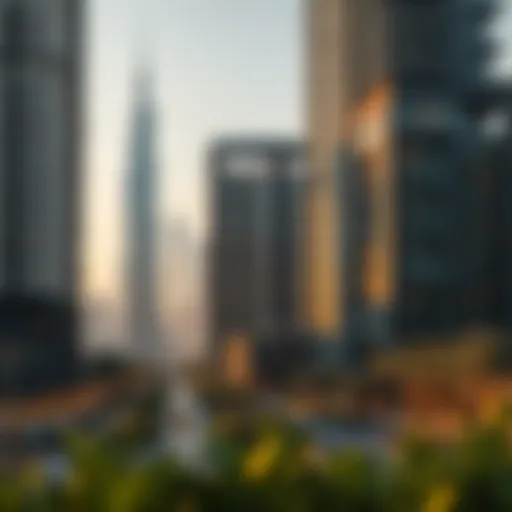Discovering Dubai's Old Market: A Cultural Journey
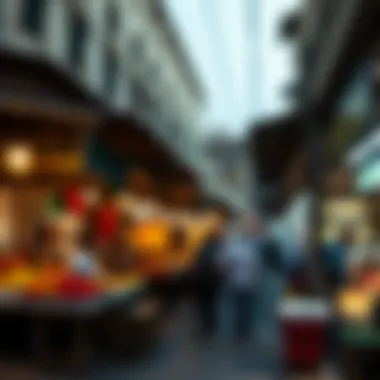

Investment Opportunities
The Old Market of Dubai, known as the Souq, stands as a vibrant nexus of commerce and culture that attracts both tourists and investors alike. This area, rich in historical significance, serves as an exemplary example of traditional markets that have adapted to modern economic dynamics. Here, we will examine key investment opportunities arising from this iconic locale.
Top Neighborhoods for Investment
Investing in the property surrounding the Old Market can yield significant returns. Several neighborhoods present prime opportunities for prospective investors:
- Al Fahidi District: Rich in heritage, this area boasts traditional buildings and art galleries. Its proximity to the market makes it appealing to developers aiming for a sophisticated yet culturally rooted clientele.
- Deira: Anchored by the Old Market, Deira is quickly becoming a CBD with its commercial hotspots and growing residential options. Investors see a strong return in retail and hospitality sectors.
- Bur Dubai: Known for its vibrant essence, the mix of old and new architecture makes this location inviting for those interested in both commercial spaces and quaint eateries.
Upcoming Developments to Watch
Several increasing projects can influence investment potential:
- Dubai Creek Harbour: This development promises to mix residential living with leisure and retail, ultimately benefiting the Old Market through increased foot traffic.
- Museum of the Future: A few kilometers away, this cultural landmark is set to draw both local visitors and international tourists, offering ancillary benefits to nearby commercial properties.
- Dubai Metro Expansion: With new stations slated to increase accessibility, the Old Market’s appeal will undoubtedly grow, making it easier for visitors and residents to explore this historic area.
Market Trends
The Old Market of Dubai has witnessed shifting trends that impact its commercial landscape. Understanding these trends can help investors make informed decisions.
Current Market Analysis
The commerce flowing through the Old Market shows signs of resilience against global economic shifts. Foot traffic remains high largely due to constant tourism and the sustained interest from both locals and expats. An analysis reveals:
- Increased demand for cultural souvenirs and local crafts.
- A noticeable uptick in culinary experiences, as food stalls and small cafes broaden offerings.
- Real estate values in surrounding areas are on an upward trajectory, reflecting both heritage value and modern development.
Future Projections and Trends
Looking ahead, various factors will play a crucial role in shaping the Old Market:
- Increased Tourism: Predictions show a steady incline in tourism, with attractions at the market expected to evolve with modern tastes while retaining traditional aspects.
- Digital Integration: As online sales grow, traditional shops may embrace e-commerce to reach broader markets without losing their essence.
- Real Estate Growth: With increasing investments in the area, property prices are likely to rise, making it imperative for investors to act promptly and strategically.
The Old Market of Dubai serves not only as a shopping destination but also as a microcosm of Dubai's cultural tapestry. With its ongoing evolution shaped by both tradition and modernity, it beckons investors and professionals eager to be part of its dynamic future. For further exploration, see Wikipedia or visit Britannica.
By paying close attention to these facets of the Old Market, stakeholders can position themselves effectively in an ever-changing landscape.
Historical Background of the Old Market
The Old Market of Dubai, steeped in its rich historical tapestry, serves as a linchpin in understanding not just the evolution of commerce in the region, but also the broader cultural framework that defines Dubai today. Recognizing the historical context provides an invaluable perspective, particularly for investors and professionals seeking to navigate the intricate interplay of tradition and modernity shaping the marketplace.
Origins and Establishment
The Old Market, often referred to as the Souk, can trace its roots back several centuries. It originally sprang up around the Dubai Creek, a natural harbor that facilitated trade and commerce between the local populations and foreign merchants. From the outset, it was not just a place to trade goods; it was a vibrant social hub where discussions flourished, deals were struck, and neighborhood alliances were formed. This establishment was not merely about selling and buying; it helped cement Dubai's role as a key trading post in the region, attracting traders all the way from Persia, India, and even further afield.
As trade expanded, so did the market, and it began to evolve into a more structured entity, becoming the heart of Dubai's economy. In these early days, one could find merchants selling spices, textiles, and precious metals. Interestingly, many of these same products still feature prominently in the market today. The Old Market's historical roots may appear humble at first; however, they reveal a profound connection between the past and the present.
Cultural Significance
The Old Market is not merely a commercial center; it embodies the cultural heartbeat of Dubai. From the intricate architecture that reflects the region's traditional design elements to the diverse tapestry of languages spoken by its patrons, the market reflects a cultural mosaic that is distinctive to the Emirate. The bustling alleys filled with aromatic spices, the vibrant textiles, and the rhythmic chatter between buyers and sellers depict a scene that is a testament to the enduring spirit of communal engagement.
Many consider the Old Market a living museum, where every corner recounts tales of yore. It is a place where various customs are preserved, such as barter trade and haggling, which are essential parts of the shopping experience. Visitors often find themselves not just purchasing items but immersing in a rich cultural experience that ties them to the lineage of Dubai's commercial aspirations.
Transformations Over Time
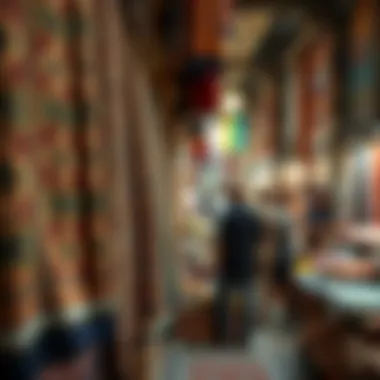

Over the decades, the Old Market has witnessed significant transformations that mirror Dubai's economic evolution. As the city embraced modernization and globalization, the market adapted to these changes while retaining its unique charm. In the late 20th century, the impact of the oil boom meant an influx of wealth and a wave of new ideas, leading to renovations and new constructions that adorned the market while still respecting its historical essence.
Today, it stands as a wonderful marriage of the old and new; you can still find traditional vendors operating alongside boutiques that offer modern goods. Some might say that the essence of the Old Market lies in these very transformations — preserving history while embracing the future. It's a living example of how a space can adapt without losing its soul, making it an essential study for investors and anyone interested in the cultural and economic fabric of Dubai.
"The Old Market represents more than mere commerce; it illustrates the evolution of a city that honors its past while eagerly stepping into the future."
Architectural Features
The Old Market in Dubai is more than just a hub for trade; it boasts a rich tapestry of architectural significance that mirrors the city’s evolution over time. Examining the architectural features of the market sheds light on its cultural authenticity and commercial viability. The design elements serve not just aesthetic purposes, but also practical ones, catering to the needs of merchants and visitors alike. As investors and property managers consider the market’s potential, understanding these features becomes paramount.
Traditional Design Elements
Traditional design elements in the Old Market reflect Dubai's historical charm and rich heritage. The predominant use of sandstone and mud bricks emphasizes the local craftsmanship characteristic of earlier architectural practices. The narrow alleys of the market create a sense of intimacy, encouraging visitors to explore. High ceilings adorned with intricate wooden lattice work allow for ventilation while showcasing the craftsmanship of local artisans. Windows with wooden shutters provide shade and cooling, ensuring the market remains a comfortable environment even during Dubai's sweltering heat.
Notably, the minarets and domes of nearby mosques intersperse the skyline, offering a contrast to the market's bustling atmosphere. The traditional souks, or marketplaces, often utilize open-air layouts that foster a community feel and invite social interactions. This design not only attracts tourists and residents but also serves to preserve traditions that have been passed down through generations.
Modern Enhancements
As the Old Market embraces modernization, several enhancements aim to elevate the visitor experience without diminishing its traditional essence. Integrations of smart technology, like digital navigation tools and enhanced lighting, improve the overall accessibility of the market, catering to modern consumers. Climate control measures have been considered, including shaded areas and misting systems that create a pleasant shopping atmosphere.
The juxtaposition of modern amenities with traditional design elements presents a compelling appeal. Modern store facades retain cultural motifs, ensuring that while the market evolves, it remains rooted in its foundational aesthetics. Retail spaces are now equipped with e-commerce capabilities, attracting a broader customer base and bolstering local businesses.
Investors eyeing opportunities in the Old Market must take into account these dual aspects of architectural features. The blend of the old with the new creates an iconic marketplace that not only celebrates Dubai’s past but also embraces its future.
"The Old Market isn’t just a place to buy and sell; it’s a living museum of Dubai’s cultural narrative, layered with historical architecture that invites exploration."
The thoughtful balance of traditional and modern architectural features positions the Old Market not only as a commercial powerhouse but also as a cultural landmark integral to Dubai's identity.
Commerce in the Old Market
The Old Market of Dubai serves as a vibrant tableau of commerce, reflecting the economic heart of the region. Here, the thrum of daily trade resonates with stories of generations past, filled with opportunities for both buyers and sellers. The variety of goods and services available are not just items on display but are a testament to the rich tapestry of cultures represented within this iconic marketplace. This section delves into the significance of commerce in the Old Market, where transactions go beyond simple exchanges of currency, embodying a deeper cultural connection and community engagement.
Types of Goods Offered
When one strolls through the winding alleys of the Old Market, the air is steeped in aromas and colors that captivate the senses. Shoppers encounter an eclectic mix of products that tell a story of local heritage.
- Spices: Spices reign supreme in the market, showcasing the region's historic ties to trade routes. Vendors often have a selection that includes cardamom, saffron, and za'atar, each with its own unique flavor and significance in Arabic cuisine.
- Textiles: From silk to cotton, textiles in brilliant hues line the stalls. These fabrics are not only a feast for the eyes but also speak of traditional craftsmanship and cultural significance, often utilized in both contemporary fashion and traditional garments.
- Gold and Jewelry: With gold souks nestled within the Old Market, it's no surprise that jewelry is a cornerstone of commerce here. The intricately designed pieces, through modern styles or traditional motifs, express a blend of artistry and cultural symbolism that attracts both locals and tourists alike.
In addition to these, one may find pottery, handicrafts, and even henna—each item laden with meaning, serving as a reminder of the craftsmanship and passion invested by local artisans.
Local Artisans and Their Crafts
The spirit of the Old Market is not confined to just the goods sold but extends to the artisans behind them. Local craftsmen play an invaluable role in shaping the market's identity.
Their skills often passed down through generations, these artisans showcase a variety of traditional crafts:
- Ceramics: From hand-painted plates to intricate mosaic tiles, ceramic artistry captivates those who appreciate handcrafted work.
- Woodwork: Carpenters and woodworkers skillfully fashion items like intricate furniture to small trinkets, appealing to those with a taste for unique, high-quality pieces.
- Textile Weaving: Weaving is an art form practiced by many in the Old Market. The textiles not only provide material items but also instill a sense of pride and identity among local craftsmen.
Through their craftsmanship, local artisans contribute not only to the commercial aspects of the market but also to its cultural narrative, preserving traditions that might otherwise fade.
Economic Impact
As one of the oldest commercial hubs in Dubai, the Old Market significantly impacts the local and national economy. Its economic essence can be broken down into several key areas:
- Job Creation: The working atmosphere supports a diverse range of jobs, from shopkeepers to artisans, ensuring stability and economic growth within the community.
- Tourism Attraction: Tourists flock to the market for its authenticity, enhancing trade and driving demand for local products. This inevitably feeds back into the local economy, offering a robust revenue stream.
- Small Business Growth: The Old Market has long provided a low-barrier entry point for entrepreneurs. Many have established successful businesses, benefiting from foot traffic and a sense of community that is unique to the Old Market.
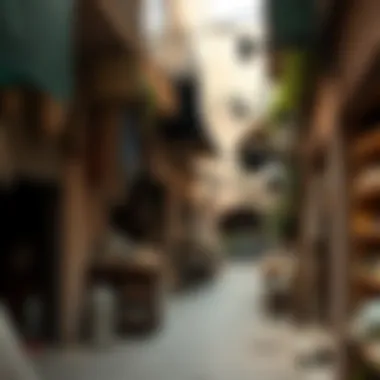

The Old Market is not just a place for transactions; it embodies economic vitality that propels both individual growth and collective prosperity.
Visitor Experience
The visitor experience at the Old Market of Dubai is a crucial aspect of its appeal. The ambiance, the diversity of offerings, and the interactions with local cultures blend seamlessly, making each visit a memorable affair. Tourists and investors alike can glean valuable insights into the local heritage and current market trends. The Old Market serves as a microcosm of Dubai itself—vibrant, multifaceted, and rich in history.
Navigating the Market
Navigating the bustling pathways of the Old Market can be an adventure in itself. The layout is typically labyrinthine, with narrow alleys weaving through a medley of stalls. Here are a few tips for first-time visitors:
- Engage a Local Guide: Knowledgeable guides can provide context that enriches the experience, helping you discover hidden gems often overlooked by casual shoppers.
- Embrace the Senses: Don’t rush through your visit. Take the time to inhale the fragrances of spices, admire intricate textiles, and touch unique crafts. Each stall tells a story; engaging with vendors can unlock fascinating anecdotes.
- Shop Wisely: Haggling is not just accepted; it’s a tradition. Don’t shy away from bargaining; you may end up with a better deal and a smile from the vendor.
The Old Market is not just a shopping destination; it's a journey through time, a place where the past and present intersect.
Dining and Refreshment Options
The culinary scene within the Old Market is equally engaging, offering a wide array of dining and refreshment options. Here are some highlights:
- Street Food Delights: Vendors serving traditional dishes such as shawarma and falafel can be found at every corner. The flavors are authentic, often made from recipes passed down through generations.
- Tea and Coffee Houses: Alongside the bustling stalls, small cafes invite weary travelers to rest. Enjoy a cup of karak tea or Arabic coffee, prepared in time-honored ways that provide a refreshing break before continuing your exploration.
- Fine Dining Experiences: For those looking for something a bit more upscale, there are a few restaurants offering a blend of traditional and modern cuisines, allowing guests to dine al fresco while taking in the sights and sounds of the market.
When visiting the Old Market, don't overlook these culinary spots. Whether you're in the mood for a quick snack or a multiple-course meal, there's something to satisfy every palate.
Investment Opportunities
Investment opportunities within the Old Market of Dubai represent a significant facet of the broader economic landscape in the region. This area, steeped in history and cultural vibrancy, presents a unique combination of tradition and modernity, making it attractive for a variety of investors. The allure lies not only in the thriving commerce but also in the potential for growth and development that capitalizes on the unique characteristics of the market. Understanding these opportunities can provide a roadmap to lucrative returns and sustained growth in this competitive environment.
Commercial Property Prospects
Investors looking to dive into the commercial property scene in the Old Market will find a wealth of prospects. The rise of tourism, combined with a desire for authentic experiences, drives demand for retail spaces that embrace local culture. Properties here can vary from boutique shops to larger commercial establishments, with potential customers ranging from tourists to local residents seeking quality goods.
Key reasons to consider investing in commercial properties include:
- Location: The Old Market is strategically placed within close proximity to major tourist attractions, naturally drawing foot traffic and increasing visibility for businesses.
- Cultural Appeal: Commercial properties that showcase local craftsmanship and traditions can carve out a niche market, catering to tourists and local patrons alike who value authenticity.
- Rental Returns: With the influx of visitors, rental properties, particularly those that accommodate shops or eateries, are likely to see strong occupancy rates, leading to favorable rental income.
- Government Support: Local government initiatives aimed at revitalizing historical areas can provide incentives for investors, from grants to reduced licensing fees.
Potential for Tourism-Driven Ventures
The potential for tourism-driven ventures in the Old Market is immense, fueled by Dubai's reputation as a shopping and cultural destination. Investors can explore various avenues that harness this momentum, including:
- Cultural Experiences: Projects centered around workshops or demonstrations that showcase local art and craftsmanship can attract both tourists and locals eager to learn and engage.
- Dining Options: The market is an ideal spot for establishing restaurants or cafes that offer traditional and modern twists on local cuisine. Culinary experiences can significantly enhance the visitor experience.
- Guided Tours: Ventures that provide guided experiences can thrive, offering tourists insights into the history and stories behind the market and its various stalls.
- Event Spaces: Creating venues for cultural events, festivals, or exhibitions could present additional avenues for revenue, while also enriching the community.
If you are looking to tap into the essence of Dubai's commercial heartbeat while enjoying the benefits of a thriving tourist economy, this market holds countless opportunities worth exploring.
"Investing in the Old Market is not just about profit; it’s about being part of a living tradition that shapes Dubai’s identity."
By keeping these factors in mind, potential investors can make informed decisions, aligning their goals with the vibrant pulse of the Old Market. The possibilities are not just promising; they are a call to action for those who understand the dynamics of commerce interwoven with cultural heritage.
For further details on property trends, you can visit Encyclopedia Britannica, and check investment guidelines at websites like Dubai Government.
Engagement with local real estate agencies could also provide additional perspectives on the specific nuances of the market.
Cultural Events and Festivals
The Old Market of Dubai serves as a vibrant hub of activity not just for commerce but also for cultural expression. This facet of the marketplace, specifically its cultural events and festivals, plays a vital role in nurturing community spirit while attracting tourism. Highlighting traditions, celebrating various aspects of life, and fostering creativity are some core elements of these events. They enable local artisans, tradesmen, and everyday folk to showcase their skills and celebrate their heritage. More than just a spectacle, these events knit together the social fabric of the region, offering an authentic glimpse into the soul of Dubai.
Historical Celebrations
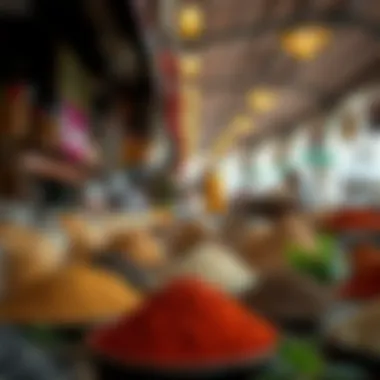

The historical celebrations of the Old Market echo the deep-rooted traditions of Dubai. These celebrations are often tied to significant days in the Islamic calendar, such as Eid al-Fitr and Eid al-Adha. During these times, the market transforms into a scene of festivity, bustling with families and friends coming together to enjoy the spirit of the occasion.
Residents engage in the art of culinary storytelling, unveiling traditional dishes that haven't changed for generations. It's common to see booths overflowing with dates, special sweets, and hearty meals that tell tales of times gone by. Beyond the food, thumping Arabic music fills the air, drawing in locals and tourists alike into a dance of cultural celebration.
For investors and property managers, understanding the impact of these historical celebrations can be insightful. Not only do they draw crowds, fostering a booming atmosphere, but they also translate into long-term business opportunities. With a deeper understanding of how local traditions shape commercial dynamics, stakeholders can better position themselves to tap into this rich vein of cultural wealth.
Modern Day Festivals
In contrast, modern-day festivals offer a different flavor, mixing traditional elements with contemporary flair. Events like the Dubai Shopping Festival and the Dubai Food Festival inject a fresh perspective into the Old Market, blending modern commerce with heritage. These festivals often involve a range of activities: culinary competitions, artistic showcases, and live performances that celebrate both local and international culture.
During the Dubai Shopping Festival, for instance, shops across the Old Market present discounts and exclusive products, appealing to a global audience. Art installations can be sprinkled throughout the plaza, showcasing local talent while creating unique Instagrammable moments that entice a younger demographic.
The draw of such festivals is not just for the immediate financial benefits but also for the long-term positioning of the Old Market as a vibrant destination. For investors, it highlights the adaptability and potential for growth in the area. The synthesis of old and new could inspire innovative business models geared towards sustainability and community engagement.
By supporting or investing in these festivals, property managers and entrepreneurs can stimulate the local economy while raising their own profiles within the community. It's a win-win scenario, where honoring tradition meets the elusive charm of modernity.
Cultural events and festivals not only enhance tourist experiences but also serve as a canvas where the past and future of Dubai converge.
In sum, the cultural events and festivals hosted at the Old Market are far more than mere celebrations. They represent a living, breathing connection to both the history and future of Dubai, presenting numerous opportunities for those engaged with the market, whether that's for investment, tourism, or community-building.
Sustainability and Community Initiatives
The Old Market in Dubai is not just a hub of commerce; it operates at the intersection of history, community, and environmental responsibility. In recent years, sustainability has become paramount in the market’s framework as more stakeholders recognize the intertwined nature of economic viability and ecological stewardship. Investors and local businesses are eager to incorporate sustainable practices, knowing that such initiatives can enhance their reputation and, ultimately, their bottom line. This section looks into two critical facets: eco-friendly practices and community engagement.
Eco-Friendly Practices
In exploring eco-friendly practices within the Old Market, it’s essential to account for both the historical context and modern innovations being integrated. Traditional trading practices have emphasized local sustainability, using available materials and resources efficiently. Today, these practices are evolving, fueled by developments in technology and increasing awareness of environmental issues.
Several initiatives have emerged:
- Waste Management Initiatives: Vendors across the Old Market are increasingly participating in recycling programs aimed at minimizing waste. Be it leftover food or packaging materials, there is a collective move towards responsible waste disposal. Positive outcomes include reduced landfill contributions and enhanced local environment.
- Sustainable Products: Some merchants have begun to offer products sourced from sustainable practices, such as ethically-grown spices or handmade crafts from natural materials. This shift not only addresses consumer demand for green products but also supports local artisans.
- Energy Efficiency: Various shops are integrating solar panels, using natural ventilation, and employing energy-efficient lighting, which reduces carbon footprints and lowers operating costs in the long run.
The collective efforts signal a strong community commitment to fostering a market that respects the environment and nurtures local health. It’s a win-win situation, promoting both sustainability and profitability.
Community Engagement
Community engagement forms the backbone of the Old Market’s identity. The market isn’t merely a site for transactions; it is a social gathering point, deeply rooted in the culture of Dubai. The following elements illustrate how community and sustainability go hand in hand:
- Local Projects: Regular workshops and seminars concerning sustainability practices are organized within the market. These are attended by both vendors and community members, allowing for knowledge-sharing on eco-friendly practices.
- Involvement in Local Economy: The market relies on local suppliers, which reinforces economic bonds among community members. Supporting local enterprises not only keeps money within the community but also strengthens social ties, creating a resilient local economy.
- Cultural Festivals: Events held in the Old Market often focus on sustainability themes, promoting local products and educating visitors on the importance of preserving traditional methods alongside modern practices. Such events foster a sense of ownership and pride among residents, which is crucial in community sustainability.
"Community initiatives drive both a robust local economy and foster the cultural heritage that defines the Old Market."
The Old Market serves as a microcosm of how sustainability and community can coexist. Stakeholders are recognizing that by embracing eco-friendly practices and prioritizing community engagement, they can create an environment that benefits not just the present generation but also generations to come. Such initiatives are not just trends; they are the future of commerce in this historical marketplace.
Future of the Old Market
The future of the Old Market in Dubai is a crucial aspect of this exploration, reflecting ongoing changes in both urban development and cultural heritage preservation. As the city itself accelerates into a more modern era, the market serves as a living bridge connecting Dubai's rich history with its dynamic present. Investors, property managers, and industry professionals need to understand the trends shaping the future of this iconic locale to harness its potential effectively.
Challenges Ahead
The Old Market faces several challenges that could impact its long-term viability. One significant hurdle is the rapid urbanization engulfing Dubai. As high-rise buildings sprout in the vicinity, the historic market risks losing its identity amidst the skyscrapers. Preservation efforts must be balanced with the inevitable march of progress.
Another challenge stems from changing consumer preferences. Shoppers now increasingly favor online retail, which could pose a threat to traditional marketplaces like the Old Market. Consequently, local vendors need to adapt by integrating e-commerce strategies or enhancing the physical shopping experience to draw in customers.
Additionally, regulatory pressures can create hurdles. Balancing modern-day requirements, such as safety and accessibility, with the need to maintain the traditional aesthetics poses a complex challenge for authorities. The wet market needs to comply with newer guidelines yet retain its authenticity.
Opportunities for Growth
Despite these challenges, the future is not all grim for the Old Market. There are numerous opportunities for growth waiting to be tapped into. One such opportunity lies in eco-tourism, an increasing trend globally. By promoting sustainable practices and showcasing local artisans, the market can attract a more conscientious consumer base interested in ethical shopping experiences.
Property managers and investors should take heart in the burgeoning interest in cultural tourism. As travelers seek authentic experiences, the Old Market can position itself as a must-visit destination. Promotions highlighting its unique products, cultural significance, and vibrant ambiance can draw tourists eager to experience the essence of Dubai.
Furthermore, partnerships with local businesses can cultivate a symbiotic relationship, where the market becomes a hub for community gatherings, events, and festivals. Embracing modern technology can also enhance operations; think mobile payment options and online platforms that facilitate local commerce without dismantling tradition.
In summary, the future of the Old Market in Dubai rests upon its ability to navigate through challenges while seizing growth opportunities. The interplay between preserving its historical charm and adapting to contemporary needs will be pivotal in maintaining its relevance as both a commercial entity and a cultural landmark.

